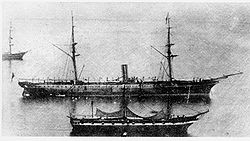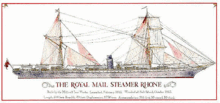RMS Rhone
|
||||||||||||||||||
|
||||||||||||||||||
|
||||||||||||||||||
|
||||||||||||||||||
The RMS Rhone was a passenger ship of the British shipping company Royal Mail Line put into service in 1865 , which got into the San Narciso Hurricane and sank on October 29, 1867 in the British Virgin Islands . Of the more than 147 people on board, only 23 survived, all of them crew members. The passengers drowned because they were tied to their beds according to the customs of the time so as not to fall out in the storm . The wreck of the Rhone is now a popular diving destination.
The ship
The passenger and mail ship RMS Rhone was a 2,378 GRT steamship built for the Royal Mail Line at Millwall Ironworks on the Isle of Dogs in London . The 94.5-meter-long and 12.2-meter wide ship was on 11 February 1865 by the stack and was found in August 1865 in service. The Rhone was built for trade from England to Central and South America and the Caribbean . The ship had a chimney, two masts and a single propeller . The propeller was only the second to be cast from bronze . The Rhone was one of the first ships to be built of iron . It was powered by both a steam engine and sailing power.
Her maiden voyage took the Rhone to Brazil , which was also the destination of her next five crossings. During this time, she established herself as particularly seaworthy as she mastered several storms . After the voyages to Brazil, the ship was moved to the West Indies route in the Caribbean. The Rhone turned out to be very popular with customers, as it was able to reach a speed of 14 knots, which was unusually high for the time. The luxurious cabins and lounges also contributed to the good reputation of the ship. 253 passengers in first class and 30 each in second and third class could be accommodated.
Downfall
On October 19, 1867, the Rhone docked next to the wooden paddle steamer Conway (built 1846, 895 GRT) in Great Harbor on Peter Island , one of the British Virgin Islands, to replenish its coal reserves. The actually intended port of Saint Thomas could not be called because of an outbreak of yellow fever . The captain of the Rhone , Robert F. Wooley, watched the barometer fall and the sky darken. It was the San Narciso Hurricane , the ninth and last hurricane of the Atlantic hurricane season in 1867. The Rhone and the Conway stayed in Great Harbor because of the approaching storm.
The first half of the storm passed without damage. The captains of both ships feared, however, that after they were out of the eye of the storm, they could be thrown onto the coast of Peter Island by the storm. They therefore decided on October 29th to transfer the passengers of the Conway to the Rhone , as this was considered safer. As was customary at the time, passengers were tied to their beds to prevent them from falling out in the stormy seas. The Conway then set out for Road Harbor and the Rhone ran out into the open sea. The Conway , which ran out earlier than the Rhone , was still hit by the foothills of the hurricane and sank south of Tortola with the entire crew. There were no survivors.
When the Rhone was about to leave, it was found that its anchor was stuck in a coral reef and could not be cleared. The anchor rope was then cut (the anchor is still in the same place in Great Harbor today). Captain Wooley wanted to take refuge in the open sea and pass between Black Rock Point on Salt Island and Dead Chest Island. Between the two islands lies the underwater reef Blonde Rock, which would not have posed any danger in normal seas, but could be dangerous under the given circumstances. Captain Wooley therefore circumnavigated it widely.
Just as the ship was passing Black Rock Point, the second half of the hurricane was rolling in from the south. The wind shifted and the Rhone was thrown directly against the rocks of Black Rock Point. Captain Wooley is said to have gone overboard. The ship sank very quickly; the bow section in 24 meters deep water and the stern section in 9 meters deep water. Of the 147 passengers and crew on the Rhone and the unrecorded passengers on the Conway , only 23 survived, all of them from the crew. Some of them clung to the rigging and masts that protruded from the shallow water after sinking for hours . Local fishermen helped the men ashore. Many of the dead were on a cemetery buried in Salt Iceland. The San Narciso Hurricane destroyed around 80 ships at the end of October 1867 and claimed more than 800 lives.
The wreck
As the wreck of the Rhone lies in shallow water, it was viewed by the Royal Navy as a hazard to shipping. In the 1950s, the stern was therefore blown up, which was only a few meters below the surface of the water. In 1967 the area around the wreck ( 18 ° 20 ′ 36.9 ″ N , 64 ° 30 ′ 44.4 ″ W, ) became the National park declared. As an artificial reef, the wreck of the Rhone is now a popular diving destination and habitat for numerous marine life.
A teaspoon embedded in one of the coral banks is attributed to Captain Wooley. The Rhone served as the backdrop for the 1977 film Die Tief .


